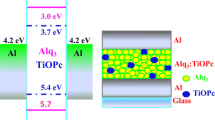Abstract.
The various electrical properties and the nature of conduction mechanisms of magnesium phthalocyanine thin film devices with top and bottom aluminium electrodes have been investigated. The conduction mechanism was identified as injection limited essentially due to the electrode material. Even with the same electrode materials, the device showed asymmetric conduction behavior in the forward and reverse bias. In general the conduction was interpreted as a Schottky emission with barrier height Φs=1.07 eV for the forward bias and Φs=1.09 eV in the reverse bias. The effect of oxygen on the conductivity of the device has also been investigated. In the oxygen doped samples the conductivity is decreased which may be attributed to an interfacial layer between the electrode and the organic layer. Further in the oxygen doped sample while a Schottky emission is observed at lower voltages Poole-Frenkel conductivity was identified in the higher voltage region.
Similar content being viewed by others
References
T. Miyata, S. Kawaguchi, M. Ishii, T. Minami, Thin Solid Films 425, 225 (2003)
M. Pfeiffer, A. Beyer, T. Fritz, K. Leo, Appl. Phys. Lett. 73, 3202 (1998)
J. Nelson, Materials Science 6, 87 (2002)
C.M. Joseph, C.S. Menon, Mater. Lett. 52, 220 (2002)
D. Hohnholz, S. Steinbrecher, M. Hanack, J. Mol. Struct. 521, 231 (2000)
K.R. Rajesh, C.S. Menon, Semicond. Sci. Technol. 20, 464 (2005)
N. Kobayashi, Coord. Chem. Rev. 219, 99 (2001)
Q. Zhou, R.D. Gould, Thin Solid Films 317, 432 (1998)
S. Ambily, C.S. Menon, Thin Solid Thin Films 347, 284 (1999)
G.B. Kamath, C.M. Joseph, C.S. Menon, Mater. Lett. 57, 730 (2002)
A.C. Varghese, C.S. Menon, Central Eur. J. Phys. 3, 8 (2005)
K.P. Krishnakumar, C.S. Menon, Mater. Lett. 48, 64 (2001)
P.R. Binu, C.M. Joseph, K. Shreekrishnakumar, C.S. Menon, Mater. Chem. Phys. 80, 591 (2003)
A. Kumar Mahapatro, S. Ghosh, Appl. Phys. Lett. 80, 4840 (2002)
H. Peisert, M. Knupfer, J. Fink, Appl. Phys. Lett. 81, 2400 (2002)
T.S. Shafai, T.D. Anthopoulos, Thin Solid Films 398, 361 (2001)
R.D. Gould, T.S. Shafai, Superficies y Vacio 9, 226 (1999)
R.D. Gould, A.K. Hassan, Thin Solid Films 193/194, 895 (1990)
L.I. Maissel, R. Glang, Hand Book of Thin film technology (Mc Graw Hill, New York, 1983), p. 11
T.D. Anthopoulos, T.S. Shafai, J. Phys. Chem. Solids 64, 1217 (2003)
T.S. Shafai, R.D. Gould, Int. J. Electron 73, 307 (1992)
T.G. Abdel-Malik, R.M. Abdel-Latif, Physica B 205, 59 (1995)
Author information
Authors and Affiliations
Corresponding author
Rights and permissions
About this article
Cite this article
Varghese, A., Menon, C. Conduction in magnesium phthalocyanine thin films with aluminium electrodes. Eur. Phys. J. B 52, 465–468 (2006). https://doi.org/10.1140/epjb/e2006-00325-4
Received:
Published:
Issue Date:
DOI: https://doi.org/10.1140/epjb/e2006-00325-4




